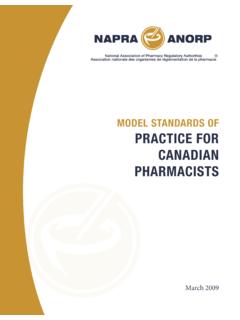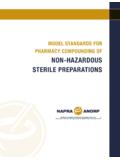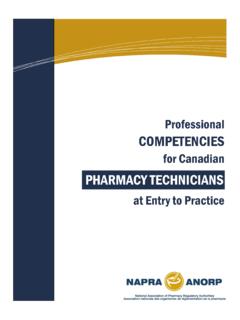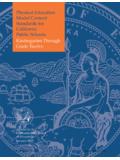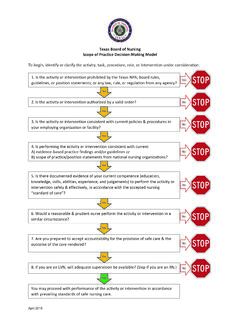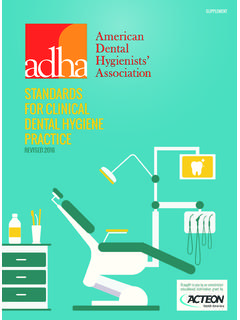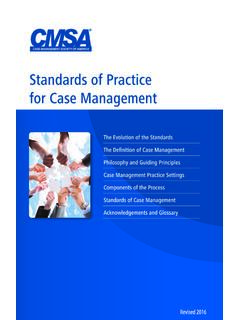Transcription of MODEL STANDARDS FOR PHARMACY COMPOUNDING OF
1 MODEL STANDARDS FOR PHARMACY COMPOUNDING OFNON-STERILEPREPARATIONSPUBLISHED WITH THE GUIDANCE DOCUMENT FOR PHARMACY COMPOUNDING OF NON-STERILE PREPARATION MODEL STANDARDS for PHARMACY COMPOUNDING of Non-sterile Preparations Published with the Guidance Document for PHARMACY COMPOUNDING of Non-sterile PreparationsApproved by the National Association of PHARMACY Regulatory Authorities (NAPRA) Board of Directors November 2017, published March 2018. Adapted with permission from Pr parations magistrales non st riles en pharmacie Norme , Ordre des pharmaciens du Qu bec, 2012 National Association of PHARMACY Regulatory Authorities, 2018. All rights reserved. No part of this document may be reproduced in any form by any photographic, electronic, mechanical or other means, or used in any information storage and retrieval system, without the written permission of the National Association of PHARMACY Regulatory Authorities (NAPRA)130 Albert Street, Suite 1800, Ottawa, ON K1P 5G4 E-mail: | Telephone: 613-569-9658 | Fax.
2 613-569-9659 ACKNOWLEDGEMENTSThe National Association of PHARMACY Regulatory Authorities (NAPRA) would like to first thank one of its members, the Ordre des pharmaciens du Qu bec, for having made possible the adaptation of its document entitled Pr parations magistrales non st riles en pharmacie Norme to create this national document, MODEL STANDARDS for PHARMACY COMPOUNDING of Non-sterile Preparations, and the accompanying Guidance Document for PHARMACY COMPOUNDING of Non-sterile Preparations. In addition, NAPRA would like to thank the members of the National Advisory Committee on PHARMACY Practice (NACPP) for their continued diligence in the development of these Connolly, Chair - Nova Scotia College of Pharmacists Anjli Acharya - Alberta College of PharmacistsGuylaine Bertrand/Annie Boulanger - Ordre des pharmaciens du Qu becHeather Christ - New Brunswick College of PharmacistsDale Cooney/Jennifer Mosher - Alberta College of PharmacistsJeanne Eriksen - Saskatchewan College of PHARMACY ProfessionalsMelanie Healey - Newfoundland and Labrador PHARMACY BoardSuzanne Solven/David Pavan - College of Pharmacists of British ColumbiaAnne Resnick - Ontario College of PharmacistsSue Sampson - Nova Scotia College of PharmacistsMichelle Wyand - Prince Edward Island College of PharmacistsTodd Mereniuk/Jill Hardy - College of Pharmacists of ManitobaNAPRA also acknowledges with thanks the support and technical contribution of Della Croteau (consultant)
3 In the preparation of these STANDARDS FOR PHARMACY COMPOUNDING OF NON-STERILE PREPARATIONSNATIONAL ASSOCIATION OF PHARMACY REGULATORY AUTHORITIES (NAPRA)1 CONTENTS1. INTRODUCTION 22. OBJECTIVES 33. REGULATORY FRAMEWORK 44. ASSESSING RISK FOR COMPOUNDING NON-STERILE PREPARATIONS 55. REQUIREMENTS FOR ALL LEVELS OF NON-STERILE COMPOUNDING ACTIVITIES COMPOUNDING personnel Training and skills assessment Policies and procedures Facilities and equipment 76. PRODUCT AND PREPARATION REQUIREMENTS 97. QUALITY ASSURANCE 118. LEVELS OF REQUIREMENTS Level A Level B Level C 129. REQUIREMENTS FOR HAZARDOUS PREPARATIONS Facilities for handling hazardous products (Level C) Equipment for handling hazardous products Deactivating, decontaminating and cleaning in areas reserved for the COMPOUNDING of hazardous non-sterile preparations Incident and accident management Hazardous waste management Verification of controlled rooms and the containment primary engineering control (C-PEC) 1410.
4 GLOSSARY OF TERMS (WITH ABBREVIATIONS) 1511. BIBLIOGRAPHY 17 MODEL STANDARDS FOR PHARMACY COMPOUNDING OF NON-STERILE PREPARATIONSNATIONAL ASSOCIATION OF PHARMACY REGULATORY AUTHORITIES (NAPRA)21. INTRODUCTIONThe Guidelines to PHARMACY COMPOUNDING published by the National Association of PHARMACY Regulatory Authorities (NAPRA) in October 2006 have recently been reviewed, a process that has resulted in a new set of documents: the MODEL STANDARDS for PHARMACY COMPOUNDING of Non-hazardous Sterile Preparations1, the MODEL STANDARDS for PHARMACY COMPOUNDING of Hazardous Sterile Preparations2, and the MODEL STANDARDS for PHARMACY COMPOUNDING of Non-sterile Preparations with its accompanying document, the Guidance Document for PHARMACY COMPOUNDING of Non-sterile Preparations (referred to hereafter as the Guidance Document).
5 The NAPRA MODEL STANDARDS for PHARMACY COMPOUNDING of Non-sterile Preparations and the accompanying Guidance Document have been adapted from STANDARDS originally developed by the Ordre des pharmaciens du Quebec, which are in turn based on General chapter <795> of the United States Pharmacopeia National Formulary (USP NF) in effect in the United States since 2004. Their preparation was led by the NAPRA National Advisory Committee on PHARMACY Practice and involved extensive consultation with experts and stakeholders. These MODEL STANDARDS and the accompanying Guidance Document are intended to ensure the safety of both patients and the personnel involved in COMPOUNDING non-sterile standard presented herein has a corresponding section in the Guidance Document with details concerning how the standard can be achieved.
6 The corresponding section is referenced in these MODEL STANDARDS by using the letters GD (for Guidance Document) and the number of the applicable section, The requirements of the applicable PHARMACY regulatory authority must also be National Association of PHARMACY Regulatory Authorities (NAPRA). MODEL STANDARDS for PHARMACY COMPOUNDING of non-hazardous sterile preparations. Ottawa, ON: NAPRA; 2015. Available from: National Association of PHARMACY Regulatory Authorities (NAPRA). MODEL STANDARDS for PHARMACY COMPOUNDING of hazardous sterile preparations. Ottawa, ON: NAPRA; 2016. Available from: MODEL STANDARDS FOR PHARMACY COMPOUNDING OF NON-STERILE PREPARATIONSNATIONAL ASSOCIATION OF PHARMACY REGULATORY AUTHORITIES (NAPRA)32. OBJECTIVESThe aim of these MODEL STANDARDS is to provide pharmacists and PHARMACY technicians who compound non-sterile preparations with the STANDARDS necessary to evaluate their practice, develop service-related procedures and implement appropriate quality controls for both patients and COMPOUNDING personnel, with a view to guaranteeing the overall quality and safety of non-sterile preparations.
7 The MODEL STANDARDS apply to all non-sterile COMPOUNDING by PHARMACY personnel; however, not every standard will apply in every practice setting. These MODEL STANDARDS will come into effect in each province/territory once they have been adopted by the respective provincial/territorial PHARMACY regulatory MODEL STANDARDS represent the minimum requirements to be applied in COMPOUNDING non-sterile preparations; however, it is always possible to exceed these STANDARDS . The use of other technologies, techniques, materials and procedures may be acceptable, if they have been proven to be equivalent or superior to those described in the accompanying Guidance Document. These MODEL STANDARDS support NAPRA s MODEL STANDARDS of Practice for Canadian Pharmacists and PHARMACY Technicians3, 4, as well as other policies and guidelines that may be in place in provincial/territorial jurisdictions.
8 As for all prescriptions, it is expected that a pharmacist will review the prescription for each non-sterile preparation and use personal expertise to determine whether the compounded preparation is appropriate for the particular patient. In addition, the pharmacist and/or PHARMACY technician who is designated as the COMPOUNDING supervisor must determine whether the appropriate knowledge and resources to develop the formulation and/or the appropriate equipment and competency to compound the preparation are available. See section in the Guidance Document for a list of questions that may be helpful in making this determination. Once a determination has been made that it is appropriate to compound the preparation, these MODEL STANDARDS must be applied. 3 National Association of PHARMACY Regulatory Authorities (NAPRA).
9 MODEL STANDARDS of practice for Canadian pharmacists. Ottawa, ON: NAPRA; 2009. Available from: National Association of PHARMACY Regulatory Authorities (NAPRA). MODEL STANDARDS of practice for Canadian PHARMACY technicians. Ottawa, ON: NAPRA; 2011. Available from: STANDARDS FOR PHARMACY COMPOUNDING OF NON-STERILE PREPARATIONSNATIONAL ASSOCIATION OF PHARMACY REGULATORY AUTHORITIES (NAPRA)43. REGULATORY FRAMEWORKA lthough compounded non-sterile preparations are sometimes prepared by other healthcare professionals, including nurses, physicians and veterinarians, the majority of non-sterile COMPOUNDING is performed by PHARMACY personnel under the supervision or direction of pharmacists. Although these MODEL STANDARDS could serve as best practices for other healthcare practitioners, they pertain specifically to COMPOUNDING by PHARMACY personnel for human or animal use5 in all PHARMACY settings where non-sterile preparations are compounded.
10 In January 2009, Health Canada developed its Policy on Manufacturing and COMPOUNDING Drug Products in Canada 6. It is expected that this Health Canada policy will be followed, along with these MODEL STANDARDS . COMPOUNDING must always occur within the context of a patient healthcare professional relationship or, in the case of a compounded veterinary product, within a veterinarian client patient relationship. In the absence of a patient-specific prescription, and with a prescriber s order for office use, compounders may prepare a compounded product at an appropriate scale, time or frequency to ensure it is being used within a patient healthcare professional relationship. Compounders may also prepare batches of compounded product in limited quantities in anticipation of future prescriptions.
